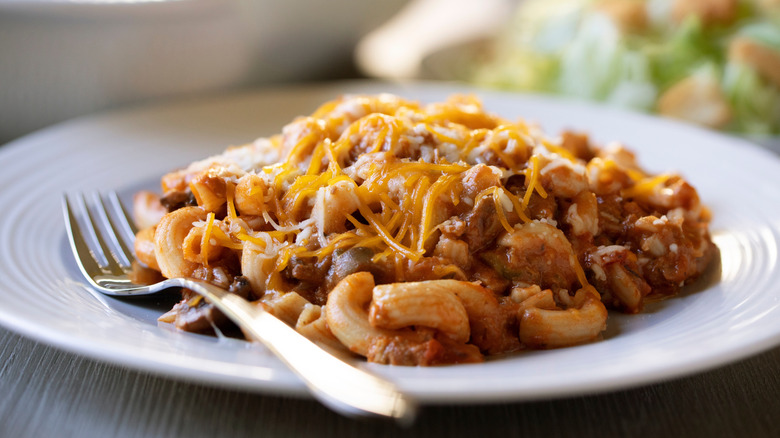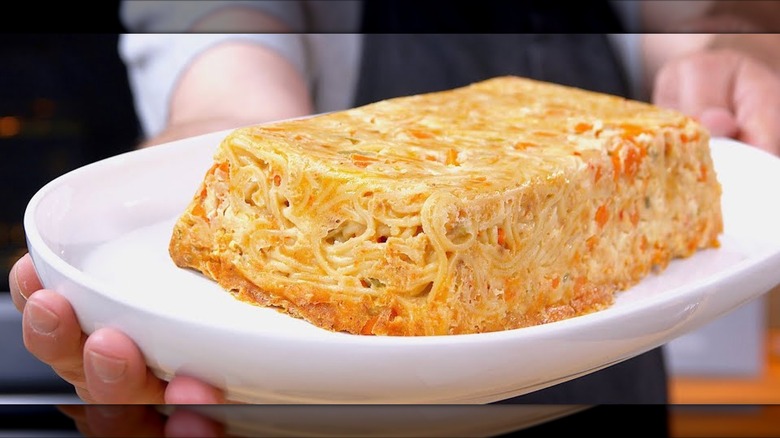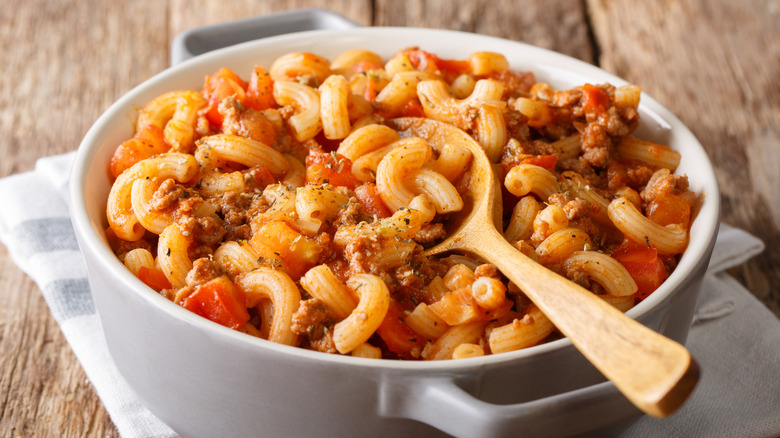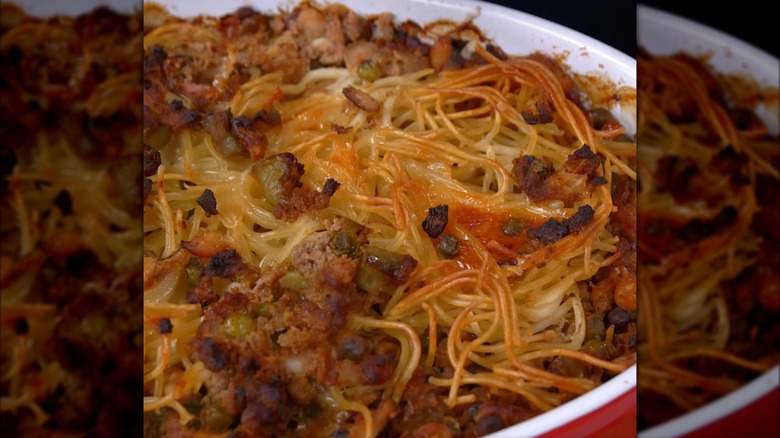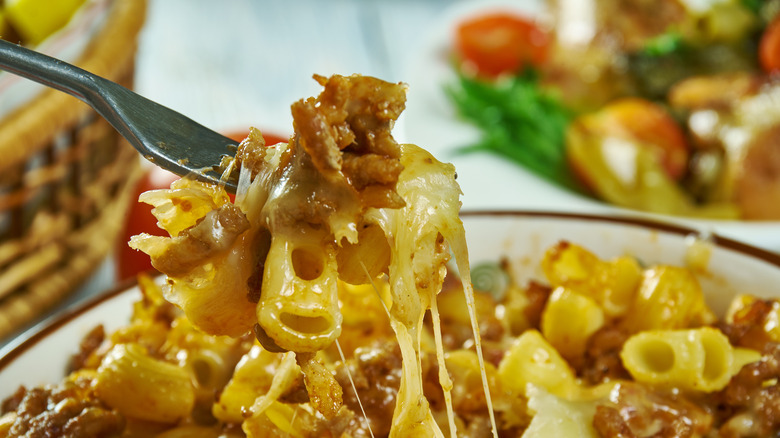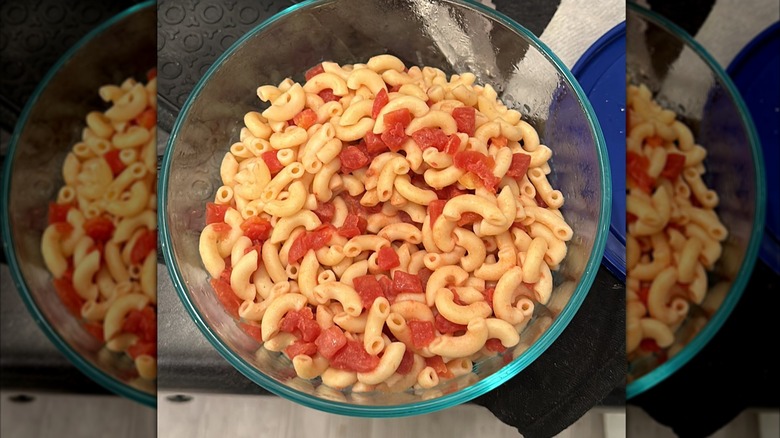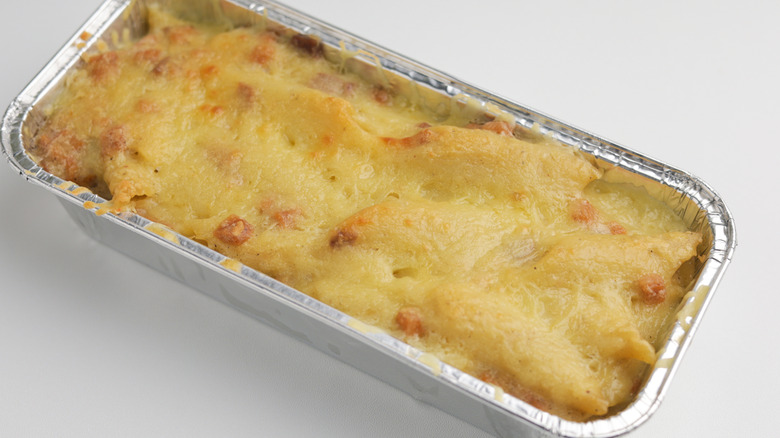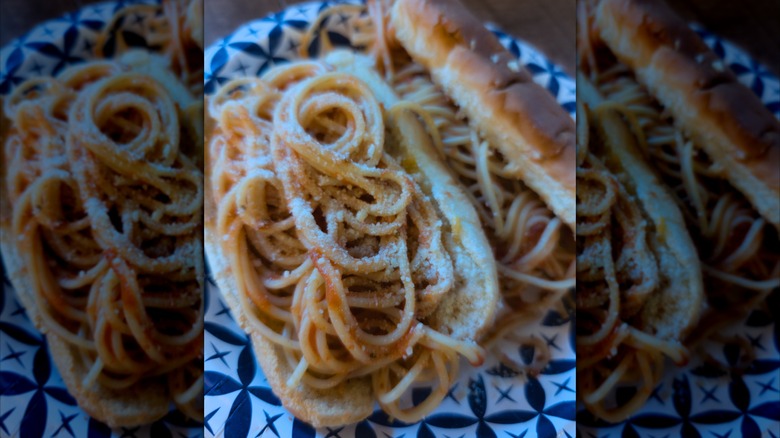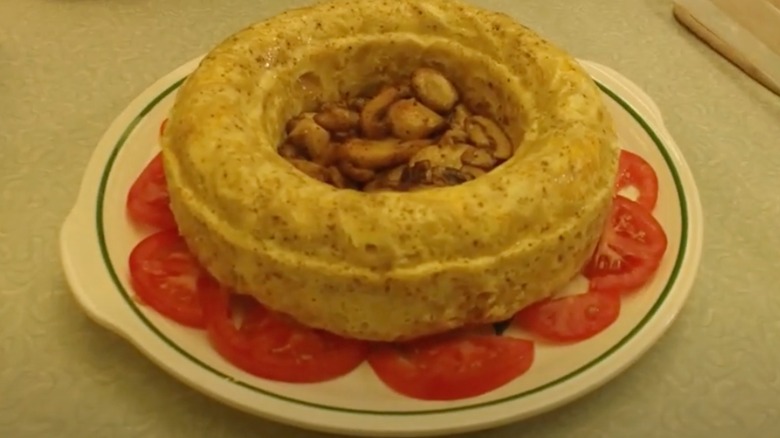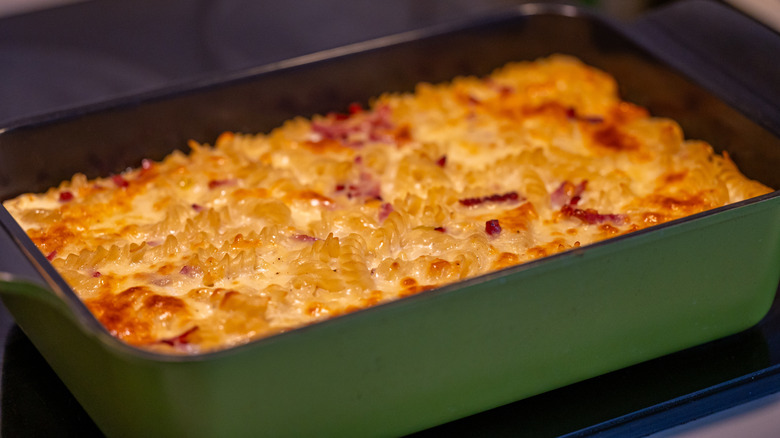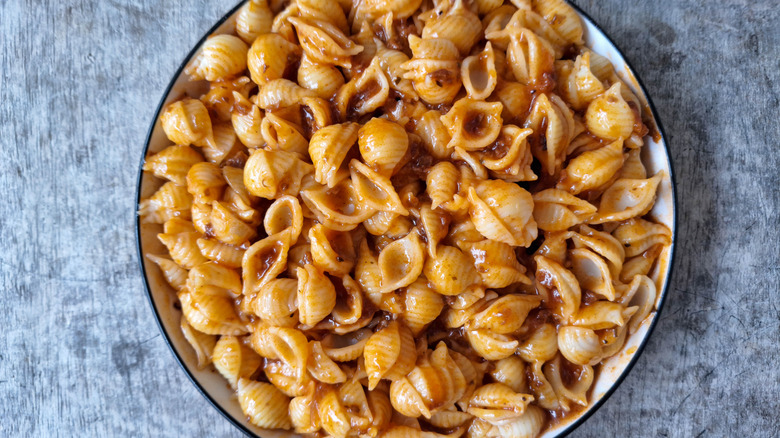11 Old-School Pasta Dishes Hardly Anyone Eats Anymore
Many of the pasta dishes we eat today have been around for centuries. Italians were enjoying the very first iteration of spaghetti and meatballs — ragu Napoletano and Bolognese ragu — as far back as the 1300s. Lasagna? Its roots go back to Ancient Greece, where they were eating laganon, cooked strips of thin dough that were then adopted by the Romans and called lagane. However, not every pasta dish has been quite so lucky as to continue finding a place on our tables.
While pasta and pasta-based dishes are pretty simple, some recipes make things unnecessarily complicated. Some recipes were born out of necessity and, once that necessity dwindled, so did our love for those dishes. In other instances, pasta dishes are a product of their times, produced by fads and discarded just as quickly. Whatever the case may be that these pasta recipes have disappeared, here are 11 old-school pasta dishes hardly anyone eats anymore, for better or for worse.
Spaghetti Aquitania
Throughout the mid-1900s, kitchens were rife with recipes derived from corporate cookbooks designed to push homemakers to buy more and more of a brand's products. In some instances, brands pushed truly delicious recipes into the mainstream, as was the case with banana pudding and Nilla Wafers. In other cases, though, the result was not so long-lived — as can be seen with the spaghetti Aquitania recipe offered up by the Atlantic Macaroni Company in 1940.
It's unclear what the "Aquitania" refers to. It could be a nod to a Roman province, or a Cunard ocean liner that was operational at the time. Whatever the case, this dish results in something a bit like a spaghetti cake. Cooked spaghetti is mixed with binding ingredients including eggs and breadcrumbs, plus some carrots and cottage cheese, among other ingredients, before being added to a loaf pan. After some time in the oven, the loaf is turned out onto a plate and garnished with nuts. It's easy to see why this dish has fallen to the wayside, though, given the fact that baked macaroni and cheese is a superior baked pasta option.
American goulash
Goulash comes in several different forms, some with pasta and some without. Hungarian goulash, the original version, can be served on top of pasta (or rice, or mashed potatoes, or any other starchy accompaniment, much like beef stroganoff), but American goulash specifically includes pasta, every time, as the pasta is cooked alongside all the other ingredients in one big dish, to form a kind of stew. Other ingredients include ground beef, tomatoes, and cheese, and the pasta shape of choice is elbow macaroni.
While less popular now, American goulash definitely enjoyed its time in the sun. After Hungarian migrants brought their version of the dish to the United States in the 19th century, the food spread and evolved, and by the 1960s it was considered one of the top meat-based dishes in the entire country.
Sadly, you don't hear of too many people now sitting down to a big bowl of goulash, but perhaps that should change. This is a dish that offers convenience and comfort food-style goodness, and while Hungarian migrants would have considered it a luxury at one time, due to the price of meat, it makes a relatively affordable meal today.
Southern spaghetti
The South can do some pasta dishes very well. Macaroni and cheese. Pasta salad. The South, though, has never really been known as a region with a rich, Italian culture that lends itself to true, authentic pasta dishes. Nowhere is that more evident than when you take a look at Southern spaghetti.
A recipe popular from the 1800s and all the way into the 1940s, southern spaghetti, at first, starts out on good footing. You boil some spaghetti. You fry some bacon. You'd think you were headed in the direction of carbonara. However, things take a left turn when you add a can of kidney beans to the mix. Beef, green peppers, peas, tomatoes, cheese, and mushrooms join the party, all in a casserole dish, layered, before you cook it for two whole hours.
Today, you're probably not going to find this dish on any Southerner's table, but if you travel a bit north to Cincinnati, you can find something slightly similar. Cincinnati-style chili tops spaghetti with a tomato-based chili that's heavy on the beef and beans.
Johnny Marzetti
Johnny Marzetti was a regional favorite throughout Ohio for much of the mid-1900s. The exact origin story differs, but one of the most widely circulated tales states that the Marzetti family created the dish, named it after one of the family members, and began serving it in their Columbus, Ohio, restaurant in 1896. The dish, which is basically a pasta-based casserole, combines noodles with ground meat and tomato sauce, baking it under a blanket of cheddar cheese. Variations exist, with some recipes calling for Campbell's tomato soup rather than tomato sauce, and others adding mushrooms.
For a time, the food was very popular in Ohio schools (which makes sense, given that it's easy, affordable, and rib-sticking). However, it's mostly disappeared from educational institutions due in part, some theorize, to the effort to get healthier foods into school systems. Additionally, there's just the fact that casseroles aren't quite as popular as they once were – but, if you like baked pasta dishes, chances are likely that you'll like the Johnny Marzetti, too.
Macaroni and tomatoes
This pasta dish couldn't be any simpler, which would make you think that it'd probably stick around. However, maybe it's that plain simplicity that's caused it to wane in popularity. There's just nothing exciting about macaroni and tomatoes.
A Southern dish, macaroni and tomatoes is literally just elbow macaroni and canned whole or diced tomatoes, tossed in butter, and seasoned with salt and pepper. If you're feeling fancy, you might add ground beef, cheese, or some extra seasonings, but it's not expected. It's thought the dish might've originated during the Great Depression, due to its affordability. However, similar dishes can be traced back even further, when, in the mid-1800s, recipes for "Italian macaroni" instructed home cooks to mix their elbow macaroni with stewed beef and tomatoes. Still, the dish's simplicity, need for few ingredients, and filling nature would have made it an ideal option in the lean years of the Great Depression.
Macaroni loaf
Don't mix this old-school pasta dish up with baked macaroni. Sure, it starts out that way, with boiling your macaroni and making a cheesy sauce from scratch. But when you start adding in all the other interesting ingredients that mid-century cooks liked to add to their macaroni loaves, and when you cook it to dry loaf consistency, and then maybe even add some tomato sauce on top, you end up with something far, far different from a creamy, baked macaroni and cheese.
One of your options for giving your macaroni loaf a little more pizzazz? Tuna, by mixing canned tuna with binding ingredients like eggs and breadcrumbs, and then layering your macaroni and cheese with the fish before baking. At least a tuna-filled macaroni loaf slightly resembles a tuna casserole. Another option was slightly more disturbing: the frankaroni loaf. For this dish, cooked macaroni is tossed with shredded cheese (not a cheese sauce!), breadcrumbs, and relish, before being layered with hot dogs and a tomato-and-olive sauce.
Irish Italian spaghetti
There's a reason why fusion cuisine can be one of the foods chefs never order at restaurants. When you start mashing cultures and cuisines together, you're bound to end up with at least a few dishes that don't really work — like Irish Italian spaghetti. A 1930s recipe, Irish Italian spaghetti relies on canned soup and spice. It utilizes cream of mushroom soup and condensed tomato soup, and adds in chili powder and hot sauce. The Irish connection is honestly unclear, but the fact remains that there are better ways you can use your spaghetti or liven up a plain pasta dish.
For example, consider adding balsamic vinegar to your plain pasta sauce for a tangy twist. You can also upgrade plain spaghetti sauce by adding ingredients such as red wine, Worcestershire sauce, any vegetables you might have on hand, coffee, or ricotta. Ditch the ground beef or Italian sausage you were thinking of adding to your pasta sauce, and add pepperoni or bacon to your pasta sauce instead.
Spaghetti sub
Whether you make it yourself or buy your meatball marinara sandwich at Costco or perhaps at Subway (where employees avoid the meaty item), a meatball sub is totally delicious. Pile on those meatballs, smother them in marinara, and top it off with melty mozzarella or provolone, all served on crusty, warm bread. A spaghetti sub lacks in comparison. And if you think a meatball sub is messy, can you imagine how hard it would be to keep all those noodles contained between two pieces of bread? Plus, before you think that this is simply your best spaghetti recipe, served on toast, think again.
A vintage spaghetti sub recipe calls for not homemade spaghetti, but cans of spaghetti, mixed with canned corn. In addition to the spaghetti, other sandwich ingredients are going on your sub rolls as well, including Italian cold cuts, provolone, onion, and relish. It is truly a monstrosity.
The spaghetti sub hasn't remained entirely in the past, though. A few restaurants throughout the States have served spaghetti sandwiches in recent years, though thankfully they seem to be made with a little more care than the vintage version. For example, at one point, a now-closed dinette in New York City served a sandwich featuring a baked patty made of chopped spaghetti, tomatoes, garlic, olive oil, and cheese. The spaghetti-patty was served on a toasted bun with garlic butter and chopped Caesar salad in lieu of lettuce.
Noodle ring
Cooks of yore loved to mold things into rings. Jell-O, fish, and, yes, noodles. The noodle ring came in various styles and featuring a range of ingredients, but was always a literal molded ring made out of noodles.
In 1959, Carnation Milk published a recipe for an olive salmon noodle ring that featured a ring of buttered egg noodles surrounding a mix of canned salmon (which is fully cooked) and olives in an onion and evaporated milk-based sauce. Other recipes allowed you to get more creative with things, and simply fill your ring with any sort of creamed chicken or seafood your heart desired. Still others veered a little over into macaroni loaf territory, by pouring a cheese sauce over the noodles before baking them into a ring, and then covering the baked ring in more cheese sauce and vegetables. Like many molded dishes of the time, the noodle ring was versatile and could be made with whatever you had on hand — and the appearance, if horrific today, was impressive to home cooks in the 1950s.
Sweet macaroni pudding
When you hear the words "sweet macaroni pudding," you might think we're talking about sweet macaroni salad. While not as common as savory macaroni salad, sweet macaroni salad is still relatively popular, and utilizes sweetened condensed milk and sugar for a sweet sauce. Then there's kugel, which is a sweet pudding-esque casserole dish containing egg noodles and a custard. Despite the potential similarities, though, sweet macaroni pudding is neither of these.
Instead, sweet macaroni pudding dates back to at least the 1860s and simply asked for home cooks to boil macaroni in milk for 45 minutes (yes, that will result in quite the mushy texture), combining it with a mixture of eggs, sugar, nutmeg, and brandy, before baking. The recipe appears in a variety of publications, including in a cookbook designed for London educational institutions, and was a firmly Victorian favorite. However, it's easy to see why this pasta dish may have fallen in popularity, given that it supposedly tastes like macaroni eggnog and the fact that a classic noodle kugel is similar, but arguably better, with its addition of cottage cheese and/or cream cheese.
Navy macaroni
Navy macaroni is a Russian invention that was supposedly created to feed sailors cheaply and easily. It's as basic as it comes. Pasta meets whatever meat is available, whether that be fresh ground beef or some sort of canned meat (more likely the latter). That's it. No pasta sauce is in sight. Once the dish spread from the confines of Russia's 19th-century navy, published recipes recommended possibly adding some onion, egg, butter, and breadcrumbs at home, but the overall result is still a fairly simple pasta dish that's affordable and convenient. Now, you can still find some individuals nostalgically making this dish using whatever they have on hand, but the historic spirit is the same.
Russia wasn't (and isn't) the only country feeding its military forces pared down pasta dishes, though. The U.S. Navy has a mild and basic macaroni and cheese recipe that similarly relies on shelf-stable, long-lasting ingredients. Meanwhile, the U.S. Marine Corps makes a chili mac that's not too far off from what you might cook up at home, complete with ground beef, seasonings like cumin and paprika, and a tomato-based sauce.
